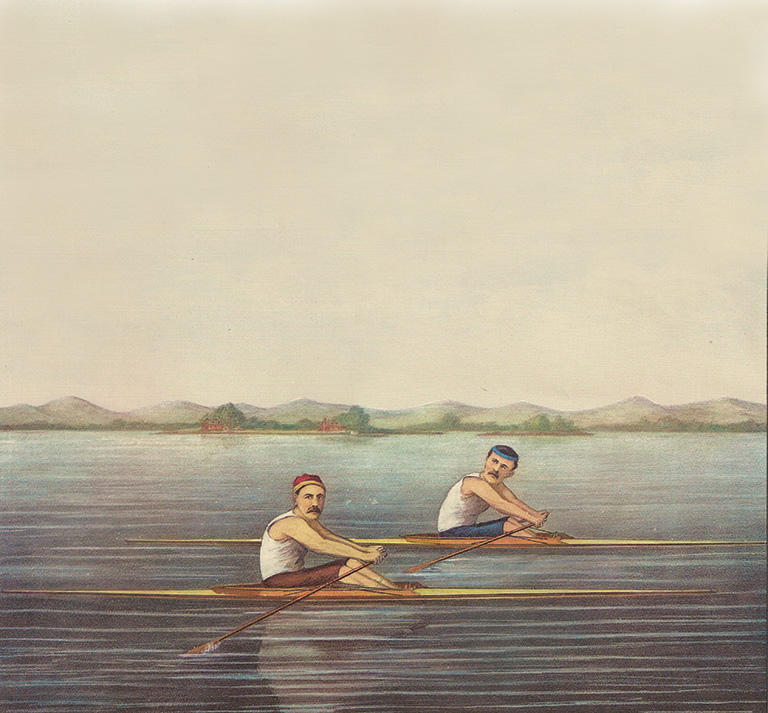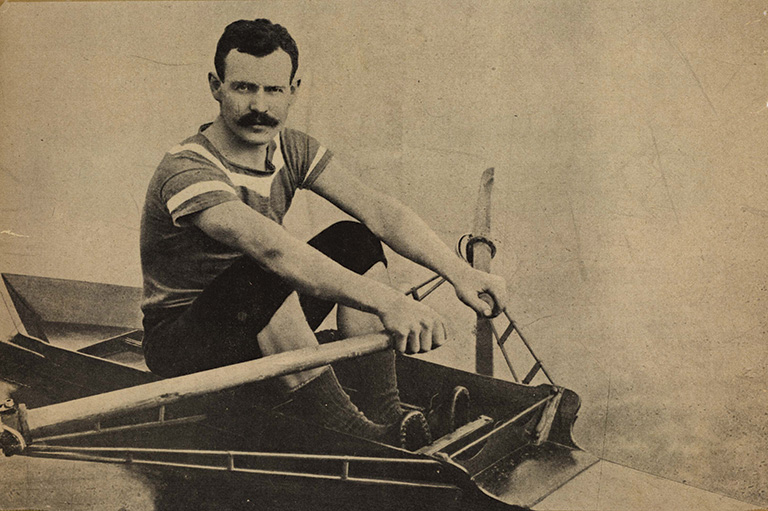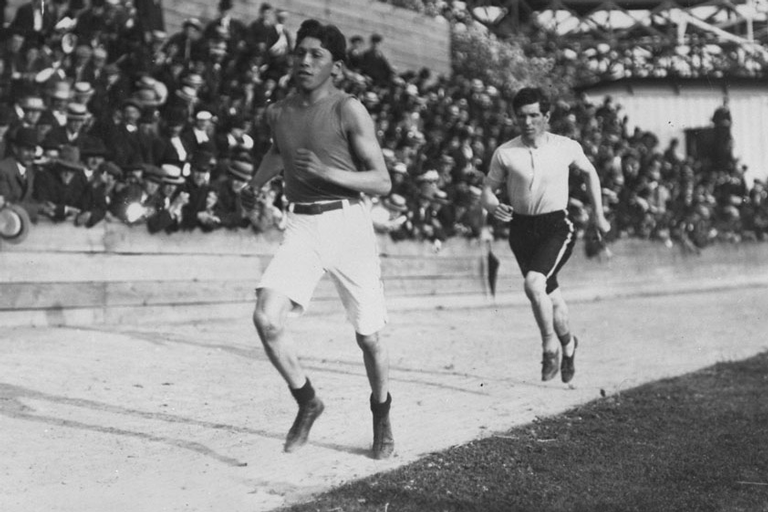Row for glory

Ned Hanlan sat in his single scull, muscles tensed, anxiously awaiting the starter’s signal. It was September 1876 and the wiry, upstart little rower was about to begin his meteoric rise to international fame.
The Canadian sculler had entered the prestigious Philadelphia Centennial Regatta as the underdog. Sure, he had won a few races up north. But this was the United States — and this event was a very big deal.
The race was part of the Philadelphia Centennial Exhibition — a world’s fair held to celebrate the one-hundredth anniversary of the founding of the United States — and the Americans were showcasing their best, including their top professional single scullers.
So when young Ned, the twenty-one-year-old son of Irish immigrants, came down from the Toronto Islands to compete against America’s finest, many laughed at his ambition.
But jaws soon dropped when Hanlan — rowing like “a small steam engine hissing through the water,” according to Toronto’s Globe — breezed past his brawnier American competitors to capture the five-kilometre course on the Schuylkill River in a record time of twenty-one minutes, nine-and-a-half seconds.
Then, to add insult to injury, it was two Canadians — Hanlan and Alex Brayley of Saint John, New Brunswick — who ended up battling each other in the finals, effectively shutting the Americans out of their own competition.
Meanwhile, on the amateur side, a man named Charles Courtney, from Union Springs, New York, emerged as the single sculls champion. Destined to become America’s next great one — he turned professional two years later — Courtney would go on to become one of Hanlan’s more controversial rivals in years to come.
Hanlan’s victory at America’s centennial celebrations gave Canada its first international sports hero. He would go on to dominate his sport, becoming a household name in places like Paris, London, and New York.
Despite his achievements, it’s likely that many Canadians are not aware of Ned Hanlan.
Hanlan’s triumphant return from Philadelphia caused a sensation in his hometown of Toronto. Scenes of patriotic pandemonium greeted the champion as he approached the waterfront aboard the SS City of Toronto.
Martial bands played patriotic tunes and tugboats blasted their horns as thousands of people crowded the dock, shouting: “Hurrah for Ned! Hurrah, Hurrah! You did it, boy!” The line of watercraft awaiting his arrival was almost two kilometres long; it was said the harbour was so thick with boats, a person could step from one craft to another and never get their feet wet. A torchlight procession followed, with thousands of fans marching up Yonge Street.

“Had Hanlan been a victorious general returning with a brilliant military record, ‘the hero of a hundred fights,’ he could not have received a greater or more hearty reception,” proclaimed an 1876 Globe newspaper editorial.
Hanlan and his wife, Mary Gibbs. The family lived at the western tip of the Toronto Islands — a place that would one day be renamed Hanlan’s Point in the rower’s honour. Young Ned grew up watching men scull on Lake Ontario and took to boating as a child, rowing to the mainland every day to attend school.
Known as the “Boy in Blue,” from his racing colours, Hanlan grew up during the golden age of Canadian professional single scullers.
In 1873, Hanlan won his first singles event, the Championship of Toronto Bay. He went on to win a string of victories on the local and national levels.
People soon began taking notice of the man dubbed the “little Canuck.” Most rowers were big men, but Hanlan stood just under five feet, nine inches, and weighed no more than 150 pounds. Yet he could row circles around his much larger competitors.
A key to his success was the way he mastered what was then an innovation in rowing — the sliding seat. The sliding seat, which most of Hanlan’s competitors also used, allowed for a greater angle in the water and the use of much more leg drive, resulting in significantly faster race times.
Hanlan developed a powerful, long stroke through the water. He trained almost thirteen kilometres per day and seldom raced at more than thirty-two strokes a minute, while his opponents rowed at a stroke rate approaching forty. To the chagrin of his competitors, he rowed with little apparent sign of fatigue or exertion.
His early victories on Toronto Bay persuaded a group of local businessmen that Hanlan was worth supporting. By 1876, they had established “The Hanlan Club,” which arranged matches, drew up contracts, and negotiated prize money. Their efforts helped the young Hanlan focus on rowing — and steered him away from the youthful indiscretions he had gotten himself into.
Local newspapers described Hanlan as “unreserved, gracious, kindly, clean, humorous, honest and sporting... with those two sterling qualities: friendliness and cleanliness of mind.”
However, he wasn’t a saint. There were temptations on the island; it’s known, for instance, that the young Hanlan sold liquor without a permit to guests outside Hanlan’s Hotel, his father’s establishment. (A story is told of one incident in which Hanlan, with the Toronto constabulary in hot pursuit, ran out the hotel door, jumped into a skiff, and rowed furiously until he caught a steamer headed for the U.S.)
Hanlan was a natural showboat. When leading a race, he would often slow down, pausing to chat with the crowds along the shore. Sometimes he would feign collapse, only to restart and take the lead again. These pranks made Hanlan a crowd favourite, but angered many of his competitors.
Spectators at the time bet heavily on the races. Hanlan’s antics were good for business, because they kept bettors guessing. In some of his biggest races, the amount gambled was the equivalent of what today would be worth between $10 million and $20 million.
The rivalry between Hanlan and the famed American rower Charles Courtney in particular fuelled rumours and scandal. The two had first crossed paths at the Philadelphia Centennial Regatta of 1876, although they did not compete against each other at that event.
As the top single scullers of their respective countries, their rivalry was heightened by the extensive coverage newspapers of the day gave to professional rowing. Race stories were often filled with jingoism and chauvinistic flair, and peppered with gossip and innuendo that fired public interest to a fever pitch in the weeks and days leading up to competitions.
In Hanlan and Courtney, the press had found its perfect story: The plucky little Canadian, dubbed “Mighty Ned,” versus the powerful American eagle. It was the newly minted Dominion of Canada versus the vaunted United States of America.
The first race between Hanlan and Courtney took place in Lachine, Quebec, in 1878 — the year Courtney turned professional.
It was a tight race until they neared the finish line of the eight-kilometre course, which was crowded with private boats and barges filled with spectators. With only five hundred metres left, barges suddenly drifted between the oarsmen and the finish line, forcing both scullers to pause. Hanlan won by only one-and-a-quarter lengths. Could Courtney have won if the barges had not interfered?
The crowd was angry and newspaper reporters were divided in their views. The New York Times claimed that Courtney was bribed $4,000 to lose the race. “Nonsense,” screamed Toronto’s Globe, with a large block headline: “Great American Eagle Screeches Fraud.” Rumours and accusations went back and forth between the handlers of each sculler, the spectators, and the press. Hanlan himself wrote a letter to the editor in the Globe, backing his backers.
With 7 uniquely curated newsletters to choose from, we have something for everyone.

In a telegraph to the Montreal Herald, dated October 4, 1878, Hanlan had this to say about Courtney and accusations of race fixing and bribery: “Mr. Courtney is a very honourable man... There is no reason why we should not row a square and honest race. Once and for all, let this be the last of it, if there has been any arrangement to insure my winning, I know nothing of it, and I feel confident that Courtney rowed to win if he could.”
On October 16, 1879, they staged a rematch known as “the Hop Bitters Race.” Held on Lake Chautauqua in Mayville, New York, it attracted 100,000 spectators to a town with a population of just a thousand. More than one hundred reporters flocked there to cover the event, which was meant to settle the issue, once and for all.
Then, on race day, it was discovered that someone had sawed Courtney’s boat in half. Newspapers called it a heinous act, one of the worst sports crimes in history. Officials asked Courtney to race in another boat, but he refused, forcing officials to cancel the race. Hanlan decided to row the course alone.
Meanwhile, furious gamblers wanted their money back. It was said that Hanlan labelled Courtney a coward, while Courtney accused Hanlan’s entourage of plotting to destroy his boat. Allegations emerged that $2,000 was promised to Courtney, win or lose, and $3,000 was promised to Hanlan if he allowed Courtney to win. The race was not re-rowed. As for the mystery of the sabotaged boat, the prevailing view was that Courtney’s handlers were responsible.
The now-bitter archrivals would go on to clash in a third race in May 1880, on the Potomac River in Washington, in front of more than 100,000 delirious spectators. The year before, Hanlan had achieved new heights of fame, winning the English Championship by eleven lengths on the Tyne River in England. Now Hanlan was back in America, ready to settle his old score against Courtney. The event was such a sensation that the U.S. Congress recessed so politicians could place their bets and watch the race.
With a staggered start, Courtney grabbed the lead, but he was soon overtaken by Hanlan. The American sculler began rowing erratically, his boat running down the lane markers. Courtney then started back down the course too soon, without having reached the turning stake. Hanlan overtook the American with ease. Courtney later claimed he had suffered heat stroke. In dismay, American reporters pocketed their stubby pencils and shuffled home.
In Hanlan and Courtney, the press had found its perfect story: The plucky little Canadian, dubbed “Mighty Ned,” versus the powerful American eagle.
One more race would make Hanlan world champion.
On November 15, 1880, the Boy in Blue found himself on the Thames River in England, the centre of the rowing universe. Hanlan’s opponent was Edward Trickett, a powerful six-foot-five-inch Australian.
Before the race, Trickett’s trainers had publicly mocked Hanlan, infuriating the Canadian. Hanlan in turn vowed to embarrass his opponent — and he was as good as his word.
Several times during the race Hanlan built a lead, then stopped rowing, allowing Trickett to catch up, only to sprint ahead again. At one point, Hanlan appeared to collapse. The scene is described by writer Frank Cosentino in the book The Canadians — Ned Hanlan:
“He had slumped forward, his oars drifting his boat slowing down under the burden of his weight and drag of the oars.
Trickett turned to see his competitor and, filled with new hope, began to pull harder.... As Trickett pulled even with Hanlan, he cast a glance over to the motionless challenger. At that moment, Hanlan raised his head and flashed a smile at the champion. Trickett was shattered.
Hanlan gave a wave to the crowd and pulled away once more...”
Trickett fared worse in a rematch held two years later. Hanlan pulled the same stunts; he even crossed the finish line, rowed back to pull alongside Trickett, and raced to the finish line again, effectively beating him twice in the same race.
Hanlan’s victories captured the imagination of the world. Canada’s Parliament paused to praise his successes. Theatres and operas stopped, and even the London and New York stock exchanges halted momentarily to celebrate his achievements. And a hundred years later, in 1980, Canada Post would put out a stamp commemorating Hanlaris world championship achievement Hanlan held the world title for four years.
Then, on August 16, 1884, Australian William Beach, a two-hundred-pound blacksmith, defeated the twenty-nine-year-old Hanlan on the Paramatta River in Sydney, Australia.
In the Dictionary of Canadian Biography, Bruce Kidd writes: “Hanlan’s friends put the blame for the loss on a second bout with typhoid, the debilitating effects of almost eight months of foreign travel, and a near collision during the race with a chartered steamer, but the muscular blacksmith was an exceptional opponent. Unlike Hanlan’s other challengers, Beach had mastered the use of the sliding seat; he also outweighed the defending champion by fifty pounds. Hanlan stayed another seven months for a rematch, but Beach beat him then, and again in 1887.”
In 1894, Hanlan retired from competitive rowing. He went on to coach and run a hotel, also serving briefly as an outspoken alderman for the Toronto Islands. Hanlan, who had married Margaret Gordon Sutherland in 1877, had six daughters and three sons, one of whom died in infancy. On January 4, 1908, Ned Hanlan, the greatest of the world’s single scullers, died of pneumonia. He was fifty-two. His funeral cortege, with about ten thousand mourners, stretched for about a kilometre along Toronto’s King Street.
Today, a symbol of his legacy stands at Hanlan’s Point, near his childhood home on the Toronto Islands. It’s a bronze statue of Hanlan, created by noted Canadian sculptor Emanuel Hahn. At its dedication in 1926, Joseph Ned Hanlan E. Thompson, Speaker of the Ontario Legislature, and his declared: “If the Battle of Waterloo was won on the playing fields of Eton, then I can safely say that Vimy Ridge was won on the rowing courses and stadia of Canada.”
Hanlan won some three hundred races in his lifetime, losing only about six. He achieved world record times over long distances that have yet to be broken. But more than that, he gave Canadians a reason to be proud.
At the height of his fame, some American newspapers tried to adopt Hanlan as one of their own. Hanlan was quick to set the record straight with trademark Canadian politeness: “There’s no harm in them calling me an American,” he told the press on one occasion. “But I am not an American in the sense that they want to have it. I was born in Canada and I am a Canadian.”
It’s been one hundred years since Hanlan’s death. His legacy was expressed by J. P Fitzgerald of the Toronto Evening Telegram, who wrote on September 3, 1926, that Hanlan “...dazzled the world as has never been done before, or since, and never will be again by any single figure.”
Save as much as 40% off the cover price! 4 issues per year as low as $29.95. Available in print and digital. Tariff-exempt!
Slippery seats

Ned Hanlan was known as the “father of the sliding seat.” While he didn’t invent the contraption, he is said to have perfected its use in rowing.
The knowledge that one could row faster and with more ease if the seat moved was known as far back as ancient Greece. Some early racers tried to gain the advantage by greasing the seat and wearing leather pants to reduce friction.
John Babcock of the Nassau Boat Club of New York is credited with inventing the first working mechanical version in 1857. It had a run of 30 centimetres and was mounted on metal rails using wooden runners. He admitted it was difficult to master:
“The tendency for a beginner is to slide too much and at the wrong time — to use it improperly is easy and pleasant, while to use it properly is difficult and fatiguing.”
By the 1870s, the sliding seat was in widespread use among competitive rowers in Europe as well as North America. However, traditional rowing with a fixed seat did not completely disappear — fixed-seat rowing competitions are still held.
We hope you’ll help us continue to share fascinating stories about Canada’s past by making a donation to Canada’s History Society today.
We highlight our nation’s diverse past by telling stories that illuminate the people, places, and events that unite us as Canadians, and by making those stories accessible to everyone through our free online content.
We are a registered charity that depends on contributions from readers like you to share inspiring and informative stories with students and citizens of all ages — award-winning stories written by Canada’s top historians, authors, journalists, and history enthusiasts.
Any amount helps, or better yet, start a monthly donation today. Your support makes all the difference. Thank you!
Themes associated with this article
Advertisement
You might also like...

Canada’s History Archive, featuring The Beaver, is now available for your browsing and searching pleasure!










